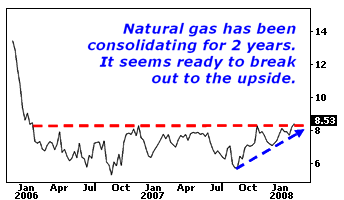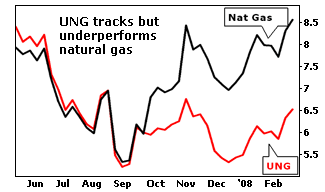Natural gas has climbed just 6% in the past year. Compare that to the 56% surge that oil has enjoyed. As a result, a barrel of crude costs about 12 times as much as 1 million BTUs of gas.
That is WAY above the average price ratio of 7.8 over the past 10 years!
Sure, that ratio can get even higher — in July 1991, in the wake of the Gulf War, oil traded at 18 times the price of natural gas.
But we're clearly at the high end of the range now, and here's the really interesting part ...
In the past decade, we've only seen three times when crude oil traded at a price more than 12 times that of natural gas. Each time, the gap narrowed to the average within four months.
So if you think oil is going higher — as I do — then it's likely that natural gas is smoking on the launch pad.
 Today, I'm going to give you an undervalued natural gas stock as well as a natural gas fund that could help you profit from a surge in natural gas prices. But first, let's look at some fundamental forces driving this market.
Today, I'm going to give you an undervalued natural gas stock as well as a natural gas fund that could help you profit from a surge in natural gas prices. But first, let's look at some fundamental forces driving this market. Gassing Up for the Future
America gets about 40% of its energy from oil, according to statistics from oil giant BP. Meanwhile, Natural gas accounts for 24% of U.S. energy supply — about as much as coal. But drillers aren't acting that way:
The number of drilled U.S. OIL wells increased 28% in the past year, according to the Energy Department.
NATURAL GAS wells DECLINED 1.1%!
And unlike the Strategic Petroleum Reserve, the U.S. has no strategic reserve for natural gas. When commercial inventories go down — and they can go down pretty quickly — there's no government safety net.
 |
| The number of drilled natural gas wells declined in 2007! |
How Low Can Inventories Go?
According to the Energy Information Administration, U.S. natural gas inventories fell 12% to 2.06 trillion cubic feet in the past 12 months. That is still above the long-term average, but according to Bloomberg news, stockpiles are at the lowest level for this time of year since 2004. Our natural gas is increasingly imported. Liquefied natural gas imports jumped 34% in 2007. Why don't we just pump it here? That's what producers are trying to do.
From a low in early 1999 of 397 active gas drilling rigs in Canada and the United States combined, the count has vaulted to 1,424 active gas rigs for the week just ended. The fact is, natural gas in North America is getting harder to find; and the gas that is found is smaller fields that flow at slower rates.
As a result, North American natural gas production has been stuck on a plateau fluctuating between 26 and 27 trillion cubic feet of production annually since 1998.
Meanwhile, Consumption Is Red-Hot …
Nationwide, consumption increased 2.8% to 1.81 trillion cubic feet in November. That probably ratcheted up in December, as arctic weather gripped the nation. And the below-normal cold we saw in January was in contrast to above-normal temperatures last year.Natural gas consumption increased by about 6% in 2007, according to the Energy Information Administration (EIA), and is expected to increase between 2% and 6% going forward.
That projection could be low — as more and more coal-fired plants are derailed by concerned citizens who don't want coal plants pumping tons of carbon dioxide and heavy metals into the atmosphere, utilities are turning to natural gas to generate electricity.
Flat supply and rising demand sound like a recipe for higher prices in my book.
How to Get Your Portfolio Cooking With Natural Gas
Now, before you run out and buy natural gas investments, be aware that the price of natural gas depends a lot on the weather … and the weather is unpredictable. Part of the reason that natural gas has been in such a slump is that this past hurricane season was a dud. While there were major storms, they never came near the U.S. coast or the gas-rich “Energy Alley” of the Gulf of Mexico.
Also, commercial traders were net short in the most recent measure, and they usually know what they're doing.
So the plays I'm going to give you are speculative. But the potential profits could also be great.
Play #1: Undervalued Natural Gas Stocks
To play natural gas, I favor producers and drillers in the U.S. One example would be XTO Energy (XTO). It is a natural gas producer with properties in Texas, Oklahoma, Kansas, New Mexico, Colorado, Arkansas, Wyoming, Louisiana and Alaska. The company has proved reserves of 6.9 trillion cubic feet of natural gas, 214.4 million barrels of oil, and 53 million barrels of natural gas liquids.
And I consider it cheap . It trades at around 15 times trailing earnings, a discount to the peer group average of 22.5.
Play #2: A Natural Gas Fund
 You could also choose a pure play on natural gas prices such as the United States Natural Gas Fund (UNG), which holds a basket of natural gas futures. Its goal is to reflect the price of natural gas at the Henry Hub in Louisiana, a nexus of 16 pipeline systems that draws supplies from the region's gas deposits. UNG has a 0.6% expense ratio that does not include commissions incurred from trading natural gas futures contracts, which are estimated to be around 0.10%.
You could also choose a pure play on natural gas prices such as the United States Natural Gas Fund (UNG), which holds a basket of natural gas futures. Its goal is to reflect the price of natural gas at the Henry Hub in Louisiana, a nexus of 16 pipeline systems that draws supplies from the region's gas deposits. UNG has a 0.6% expense ratio that does not include commissions incurred from trading natural gas futures contracts, which are estimated to be around 0.10%. Important note: Although it might trade like an ETF and is listed on an exchange, the United States Natural Gas Fund is an exchange-traded security, not an ETF. That means you don't have the protections provided to ETFs under the Investment Company Act of 1940.
I'd also like to point out that although UNG tracks natural gas, it has under-performed it (so far) due to vagaries of the futures market.
On the plus side, the fund makes it easy for investors to get commodity-like exposure and doesn't require a commodities futures account. So it is worth considering if you want a more aggressive way to play natural gas.
Good luck and good trades,
0 comments:
Post a Comment